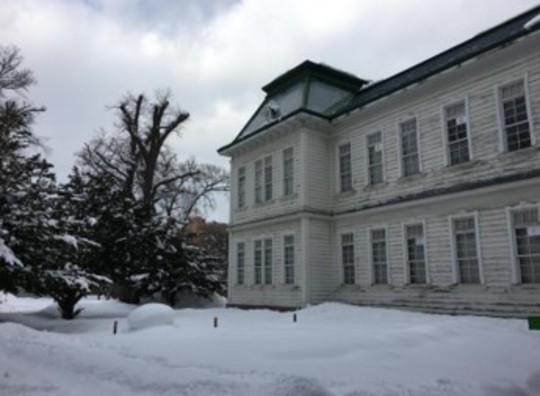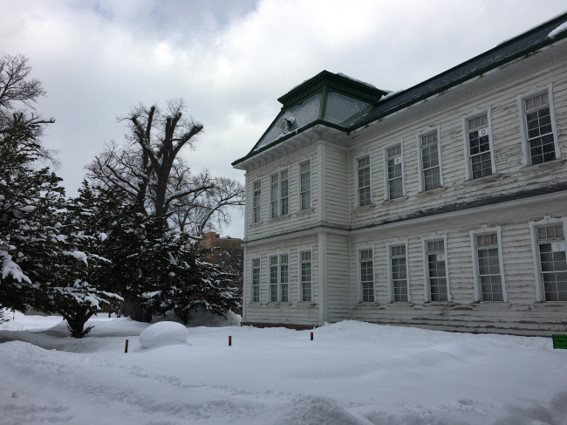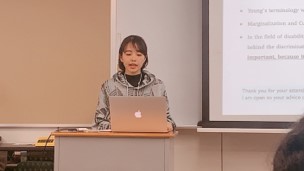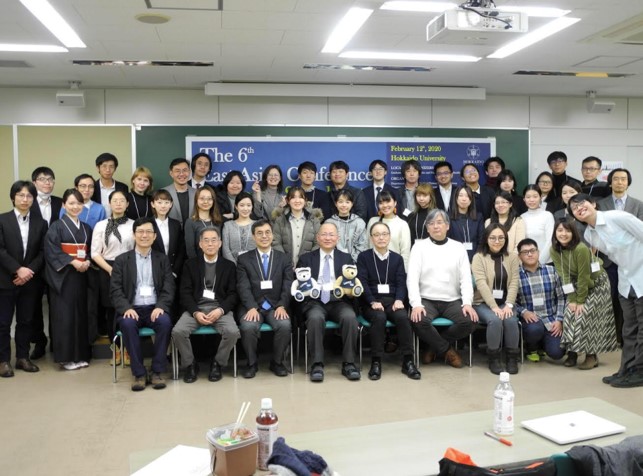
Report: 6th East Asian Conference for Young Sociologists (Sapporo, 2020) Asako Seki Hirashima
- Time and Date:
- February 12, 2020
- Venue:
- Hokkaido University (Sapporo, Japan)
- Organized by:
- Educational Project S, Integrated Human Sciences Program for Cultural Diversity (IHS), the University of Tokyo
On February 12th 2020, the East Asian Conference for Young Sociologist was held at Hokkaido University. I joined the conference as a member of the Integrated Human Science Program at the University of Tokyo, led by Prof. Shigeto Sonoda. There were nine sessions, among which I managed to join three: session 1 (“Modern Landscape of City”), session 4 (“Civil Society”), and session 7 (“Rethinking Concepts”). In this report, I would like to introduce mainly the overview of session 1 along with what I learned through joining the EACYS.

Hokkaido University covered in snow
The 1st session “Modern Landscape of City” included presentations whose topics concerned media and cultures, such as Tokusatsu films, Starbucks, the diplomacy of Kawaii Culture, and art project in Fukushima. Each theme appealed to me personally: my husband is a big fan of Tokusatsu films, I worked at Starbucks for almost 5 years before joining the IHS program, also I like fashion and my relatives lived in Fukushima. These backgrounds of mine allowed me to join this session not only as a Ph.D. student, but also out of pure interest without researcher’s mindset. I took advantage of this situation and was secretly trying to imagine how academic research can appeal to non-academics, for I have always wanted my researches to be read by non-researchers too.
While all four presentations were interesting, here let me share two presentations in particular. The first one is by Mr. Kamiya, “A Study of Documentary Nature in Fiction: Live action film [Ultraman] as the theme”. This is a case study of the Ultraman series, focusing on how the fictional story is presented in the mode of documentary films. He explicated the filming techniques that intend to affect the subjectivity of the audience, showing it with abundant pictures. For example, by placing an obstruction in front of actors, the viewer is made less emotionally involved. In other words, the obstruction allows the viewers to be more objective and neutral, which is the trait of documentary films. I myself have watched the Ultraman series before, and the analysis on the process of “documentarizing” echoes my own experience.
The second presentation is by Ms. Makino, titled “Creating a Community through an Art Project: A Case Study of the ‘Project Fukushima!’”. Her presentation was very well prepared. The part of the theoretical background was an interesting lecture itself, and it also effectively enhanced the quality of the analysis. She focused on the use of the term “culture” in the case and found two main aspects which lead to her conclusion that the project is trying to construct the “open-ended locality”.
Now, let’s get back to the secret intention that I had in mind. I mentioned that I was trying to see what would interest the non-academic audience when they listen to academic presentations. There are two answers for now: fondness that the researcher has toward his/her research topic, and the stimulation that lies in the process of analyzing.
Listening to Mr. Kamiya’s presentation, I was touched by how he was enjoying exploring the world of Ultraman. He must have watched the film over and over again. Not only that, he emphasized the importance of methods in analyzing the film. His fondness over Ultraman and his careful, methodological analysis combined struck me as exciting.
Ms.Makino’s presentation was also stimulating, for along with her analysis she showed impactful discourses she gathered during her interview. Those qualitative data seen from her well-articulated viewpoint proved to be very powerful.
Last but not least, my presentation was about rethinking the concept of oppression. My concern was that in the field of disability studies that I am involved with, the term oppression was used with neither clear definition nor systematization. I first introduced the categorization of the use of the term by political philosopher Iris Marion Young and then compared it with the categorization I extracted from the influential discourses in disability movement/studies. I indicated that while Young’s categorization worked in analyzing disability movements since the 1960s, in the field of disability studies the agent of oppression would be the key to explicate the social structure behind the discrimination, and this agent of oppression was missing in Young’s proposal. As a result, in empirical studies, the principle to focus on the agent of oppression should be carefully observed even in using Young’s five faces oppression. Prof. Satou Yoshimichi from Tohoku University was the chairman of my session and he commented that as a sociologist to carefully descript the unintentional oppression is important in my study, to which I replied that I totally agree especially because oppression in the history of disability was often expressed or performed in the form of love, such as love from parents who tried to protect the child with disability.
After the presentation, Prof. Sonoda kindly shared advice with me, pointing out that I should have mentioned why I tried to rethink the term in the first place. He also gave me other advice such as speaking louder and that I should have clarified whether I am to introduce an already completed research or I am trying to receive comments to improve an ongoing study. I am encouraged to do better next time.

My presentation was about the concept “oppression”
Through joining EACYS, I exchanged contacts with students from Taiwan, Korea, and other universities in Japan. I regret to say that students from Hong Kong could not join us due to the new coronavirus outbreak, but hopefully they will be joining next year. Finally, it’s a pleasure for me to have joined the conference where the academic community in East Asia is forming, and I hope to continue to exchange opinions with researchers worldwide and to appreciate the wide reach of each discipline.

Two polar bears in the middle are from Yonsei University, Korea
